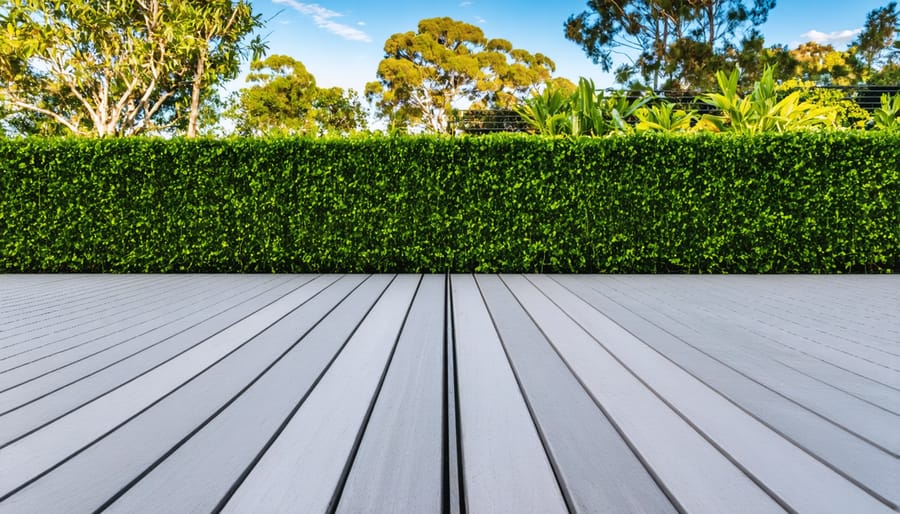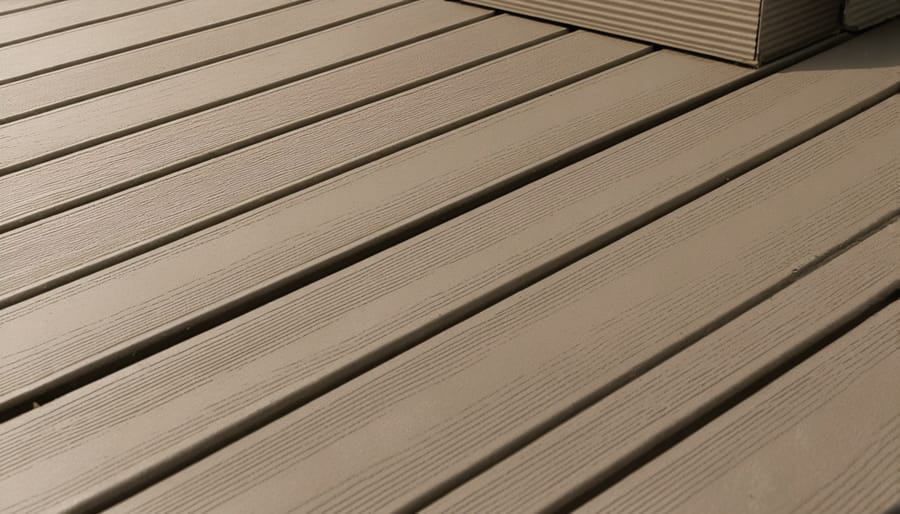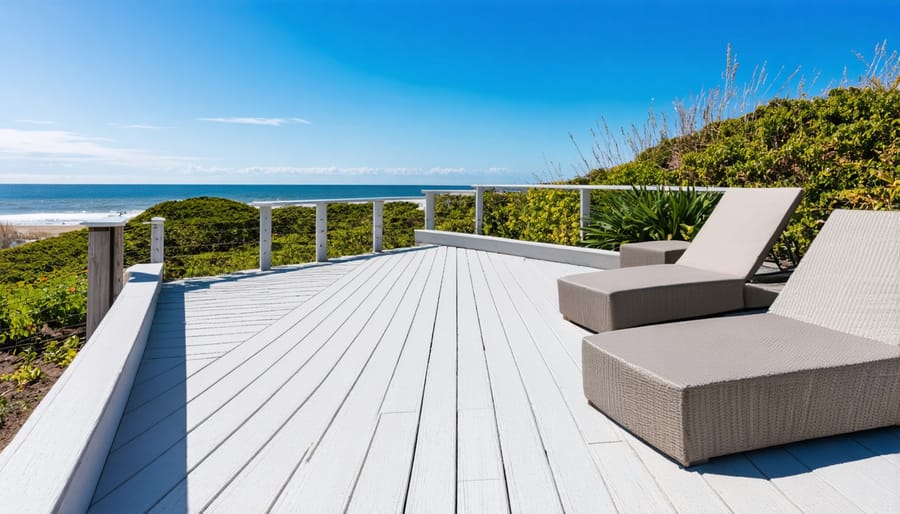Transform your outdoor space with vinyl composite decking, the innovative building material that’s revolutionising how Australians create their perfect sustainable outdoor living space. Combining the classic appeal of timber with cutting-edge polymer technology, this advanced decking solution delivers unmatched durability in Australia’s harsh climate while requiring minimal maintenance throughout its impressive 25+ year lifespan.
Unlike traditional timber, vinyl composite decking resists fading, staining, and warping, even under intense UV exposure and seasonal temperature fluctuations. It’s engineered to withstand everything from scorching summer heat to unexpected downpours, making it an ideal choice for pool surrounds, alfresco dining areas, and elevated outdoor entertainment zones.
What sets this material apart is its environmental credentials – manufactured using recycled materials and requiring no toxic treatments or stains throughout its lifetime, it’s helping Australian homeowners reduce their environmental footprint without compromising on style or performance. As we increasingly seek sustainable building solutions, vinyl composite decking stands out as a smart investment that balances beauty, durability, and ecological responsibility.
What Makes Vinyl Composite Decking Different?

The Science Behind the Blend
At the heart of composite decking innovations, vinyl composite deck materials blend recycled wood fibres with virgin and recycled vinyl polymers. This revolutionary combination typically consists of 50-60% wood particles derived from reclaimed timber waste and 40-50% vinyl materials, creating a robust and eco-friendly building material.
The manufacturing process begins with the careful selection and cleaning of recycled wood fibres, which are then dried to precise moisture levels. These fibres are mixed with heated vinyl polymers, forming a homogeneous mixture that’s enhanced with UV stabilisers, anti-fungal agents, and colour pigments specifically chosen for Australia’s harsh climate.
This mixture is then extruded through specially designed dies under high pressure and temperature, creating the distinctive profiles and textures that characterise modern composite decking. The controlled cooling process ensures optimal molecular bonding between the wood and vinyl components, resulting in boards that offer superior resistance to our unique environmental challenges, from intense summer heat to coastal salt spray.
Environmental Benefits
Vinyl composite decking stands as a testament to sustainable innovation in modern construction materials. By incorporating recycled materials – typically a blend of reclaimed wood fibres and recycled plastic – these decks give new life to materials that would otherwise end up in Australian landfills. A standard vinyl composite deck can contain up to 95% recycled content, making it a champion of circular economy principles.
The environmental impact extends beyond recycling. For every 100 square metres of vinyl composite decking installed, approximately 12 trees are saved from harvesting. This reduction in timber usage helps preserve our native forests and supports Australia’s commitment to sustainable resource management. The long lifespan of vinyl composite decking – typically 25-30 years – further reduces the environmental footprint by minimising the need for frequent replacements.
Moreover, these decks require no chemical treatments or preservatives throughout their lifetime, eliminating the release of harmful substances into our soil and waterways. This aspect is particularly relevant for our coastal areas, where traditional timber decking often requires regular chemical treatments to combat salt exposure and moisture.
Performance in Australian Climate Conditions
UV and Heat Resistance
Under the intense Australian sun, vinyl composite decking proves its worth through exceptional UV and heat resistance capabilities. Unlike traditional timber decking that can fade, warp, or crack under harsh sunlight, vinyl composite materials are specifically engineered to withstand our unique climate conditions.
The secret lies in the advanced UV inhibitors and stabilisers incorporated during manufacturing, which create a protective shield against harmful ultraviolet rays. This technology helps maintain the deck’s original colour and prevents the surface from becoming brittle or deteriorating over time, even in areas experiencing extreme temperature fluctuations.
In regions like Queensland and Northern Territory, where summer temperatures regularly soar above 40°C, vinyl composite decking maintains its structural integrity and remains cooler to touch compared to conventional decking materials. The composite blend includes special thermal-resistant compounds that help dissipate heat more effectively, making it more comfortable for bare feet during those scorching summer afternoons.
Most quality vinyl composite decking comes with warranties of 25 years or more against UV damage and fading, offering peace of mind for Australian homeowners. While initial colour settling may occur in the first few months – a natural process known as weathering – the deck will then maintain its appearance with minimal variation for decades to come.
To maximise UV and heat resistance, choosing lighter colours can help reflect more sunlight and reduce heat absorption, particularly important for pool areas and exposed entertainment spaces.

Moisture and Humidity Handling
In coastal and tropical regions across Australia, vinyl composite decking proves remarkably resilient against moisture and humidity challenges. Unlike traditional timber, these innovative boards maintain their structural integrity even in areas like Far North Queensland and the humid coastal regions of New South Wales, where moisture levels can be consistently high.
The secret lies in the manufacturing process, where wood fibres are encapsulated in polymer materials, creating a moisture-resistant barrier that prevents water absorption. This unique composition means your deck won’t swell, warp, or rot when exposed to seasonal rains or sea spray – a common concern for beachside properties.
Testing in Australian conditions has shown that quality vinyl composite decking typically absorbs less than 1% moisture, compared to up to 12% in traditional timber decking. This exceptional moisture resistance translates to fewer maintenance headaches and longer-lasting outdoor spaces for Aussie homeowners.
For tropical locations where afternoon storms are common, vinyl composite decking offers peace of mind with its superior drainage properties and quick-drying surface. The boards are designed with microscopic texturing that helps water disperse rapidly, reducing the risk of pooling and preventing the growth of mould and mildew.
Remember though, while these decks handle moisture brilliantly, ensuring proper ventilation and drainage during installation remains crucial for optimal performance in our unique climate conditions.

Maintenance and Longevity
Regular Care Tips
Keeping your vinyl composite deck in top shape is surprisingly simple, especially in our Australian climate. A regular sweep with a soft-bristled broom removes leaves and debris that could cause staining or mould growth. For general cleaning, warm water and mild soap are all you need – harsh chemical cleaners can actually do more harm than good.
During our intense summer months, give your deck a thorough wash every 4-6 weeks to prevent the buildup of dirt and pollen. Pay special attention to areas under pot plants and outdoor furniture, where moisture can accumulate. A quick spray with the garden hose between cleanings helps maintain that fresh look.
For coastal homes dealing with salt spray, increase cleaning frequency to monthly and always wipe up spills promptly to prevent staining. If you notice any mould spots, particularly during humid weather, a solution of oxygen bleach and water will sort it out safely.
Remember to check between boards occasionally for trapped debris, and ensure your drainage channels remain clear – especially important during our wet season. With these simple care routines, your vinyl composite deck will maintain its beauty for years to come.
Long-term Value Proposition
While the initial cost of vinyl composite decking may be higher than traditional timber options, its long-term value proposition makes it a compelling investment for Australian homeowners. When comparing quality decking materials, it’s essential to consider the total cost of ownership over 15-20 years.
Traditional timber decking typically requires annual maintenance, including sanding, staining, and sealing, which can cost between $2-4 per square metre each year. Factor in periodic board replacements due to rot or termite damage, and these maintenance costs add up significantly. In contrast, vinyl composite decking needs minimal upkeep beyond occasional cleaning with soap and water.
A cost analysis over a 20-year period shows that while timber decking might save you 30-40% initially, the cumulative maintenance expenses often exceed the cost difference by year 7-10. Additionally, vinyl composite’s resistance to fading, scratching, and weather damage means it maintains its appearance and structural integrity longer, preserving both your investment and your property’s value in Australia’s challenging climate conditions.
Installation Considerations
Professional vs DIY Installation
When it comes to installing vinyl composite decking, you’ve got two paths to consider: professional installation or the DIY route. While many handy Aussies might be tempted to tackle this as a weekend project, it’s worth weighing up both options carefully as part of your green renovation practices.
Professional installation typically costs more upfront but offers several advantages. Experienced installers understand local building codes, proper ventilation requirements, and the specific expansion needs of vinyl composite materials in our varied Australian climate. They’ll also have the right tools and expertise to ensure proper installation, which is crucial for maintaining your warranty and maximising your deck’s lifespan.
For the DIY enthusiast, installing vinyl composite decking is definitely achievable with proper planning and research. The modular nature of these materials makes them relatively straightforward to work with, and most manufacturers provide detailed installation guides. However, you’ll need to invest in proper tools and dedicate time to understanding the specific requirements, particularly around joisting spacing and ventilation.
Key considerations for DIY installation include:
– Proper substructure preparation
– Accurate spacing for thermal expansion
– Correct fastening techniques
– Understanding local council requirements
– Safe handling of materials
Whether you choose professional or DIY installation, ensuring proper technique is crucial for the longevity and performance of your vinyl composite deck.
Local Building Codes and Requirements
Before installing a vinyl composite deck in Australia, it’s essential to understand and comply with local building codes and standards. The National Construction Code (NCC) sets the minimum requirements for deck construction, including specific provisions for composite materials. Your deck must meet the AS 1170 standards for structural design actions and loads, ensuring it can withstand Australian weather conditions.
For residential applications, vinyl composite decking must comply with AS 4226 Guidelines for safe housing design. This includes requirements for slip resistance, particularly important in our climate where sudden rainfall can create hazardous conditions. Most quality vinyl composite decking products come with P3 or P4 slip resistance ratings, meeting Australian standards for external walkways.
Local councils may have additional requirements, particularly in bushfire-prone areas. In these zones, your deck must comply with AS 3959 Construction of buildings in bushfire-prone areas. Many vinyl composite products achieve BAL-29 to BAL-40 ratings, making them suitable for most bushfire zones.
Height restrictions and setback requirements vary by council, so check with your local authority before beginning construction. You’ll need to submit detailed plans and obtain appropriate permits. Consider engaging a licensed builder familiar with composite decking installations, as they’ll understand both the material requirements and local compliance needs.
Remember, proper documentation of compliance can protect your investment and ensure insurance coverage remains valid.
As we’ve explored throughout this article, vinyl composite decking stands as a testament to modern innovation in sustainable building materials. For Australian homeowners and builders, it represents an intelligent investment that balances environmental responsibility with practical benefits. The combination of durability, minimal maintenance requirements, and resistance to our harsh climate makes it an ideal choice for creating outdoor living spaces that last.
By choosing vinyl composite decking, you’re not just building a beautiful outdoor area – you’re making a conscious decision to reduce timber harvesting and plastic waste. The material’s long lifespan means fewer replacements over time, reducing both environmental impact and long-term costs. This aligns perfectly with Australia’s growing commitment to sustainable building practices and our collective effort to protect our unique environment.
Looking ahead, the future of outdoor living spaces in Australia is increasingly focused on sustainable solutions that don’t compromise on quality or aesthetics. Vinyl composite decking delivers on both fronts, offering the natural look we love while incorporating recycled materials and innovative technology.
Whether you’re planning a new deck for your home or upgrading an existing space, consider the lasting impact of your choice. By selecting vinyl composite decking, you’re contributing to a more sustainable future while enjoying a beautiful, durable outdoor space that will serve you well for years to come.
